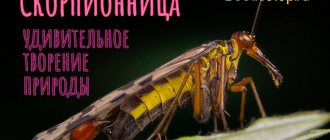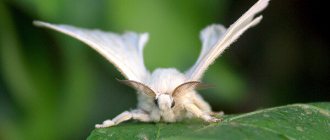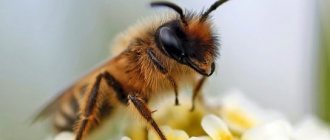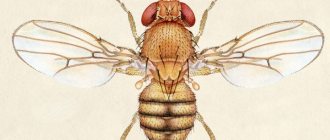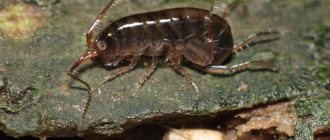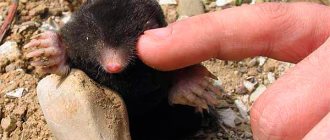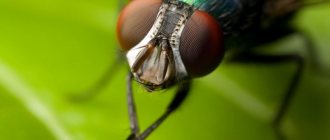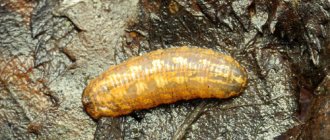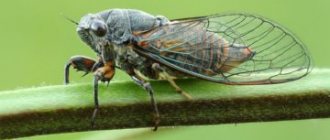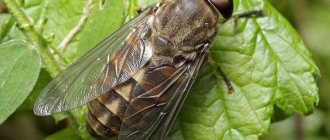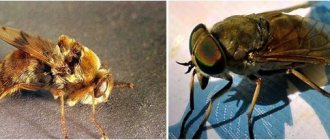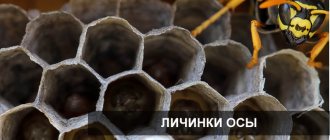Mimicry is the external similarity between different species of living beings that belong to different genera, families and orders. This is well illustrated by the hoverfly fly.
Outwardly, it is very similar to a wasp, so its other name is the wasp fly or syrphid (lat. Syrphidae). They belong to the order Diptera. These insects are widespread throughout the globe.
How to attract a hovering fly to your site
Because adult hover flies feed on pollen and nectar, planting flowering plants in your area or between crops will attract them and increase the likelihood that they will lay their eggs on infested plants.
We recommend planting plants such as: alisum, aster, coreopsis, daisies, dill, fennel, lavender, marigolds, mint, statice, sunflower, wild mustard and zinnia.
Try to keep plants rich in nectar and pollen always blooming in your area from spring to autumn.
The use of insecticides and other chemicals, especially broad-spectrum ones, should be avoided whenever possible.
Lifestyle, nutrition, reproduction
Adult insects are very maneuverable and can change direction to the exact opposite very abruptly. Thanks to the rapid movement of its wings, the fly often hovers in one place and seems to hover in the air above the flowers, as if choosing which one has the most delicacy.
The larvae are voracious, and the older they get, the more and more actively they eat. They feed mainly on small insect pests - caterpillars, psyllids, spider mites, small butterflies and aphids. They literally suck the latter alive. One syrphid larva can suck up to 200 aphids in one day, and one can imagine how a whole brood of such larvae will benefit the garden. It is on plants affected by aphids that one can often notice a cluster of syrphid larvae. In addition, the larvae can be localized in the nests of other insects, rotten rotting wood, and on large plants.
In the larval stage, flies hoverflies and overwinter. In the spring, pupae appear from them, and by the end of June, young adults appear, starting their years already in July.
During the period of courtship with females, males hover in the air above them and make a sound similar to gurgling. A similar, but slightly different sound can be heard from syrphids at other times, hence their popular name - hoverflies. Mating of these flies can occur right in the air. Also, while hovering, males protect their territory, driving away rivals.
After a while, the fertilized female lays eggs directly on the fruit trees. At one time she can lay 150-200 eggs. The emerging larvae become good crop fighters, destroying harmful insects. Therefore, in order for hoverflies to choose a garden or vegetable garden, they need more umbrella and flowering plants (both cultivated and wild), then there is a chance to acquire such useful neighbors for a permanent time.
Harm and benefits of beeweed
By feeding on pests such as aphids, hoverfly larvae protect fruit trees or shrubs from such parasites. And if they live in mountainous areas where the number of bees is reduced, then syrphids provide a great service to people. They actively pollinate flowering crops, significantly increasing their yield.
On the other hand, some species of wasp flies cause serious damage to bulb crops. Gardeners and flower growers suffer from the larvae of such insects when they damage onions, garlic or bulbs of tulips, daffodils, and hyacinth. Damaged plants slow down their growth and often wither. And harvested onions or garlic, which have been attacked by syrphids, are stored very little and quickly rot.
Life cycle and habitat
Like other flies, soaring flies go through all stages of insect life: egg, larva, pupa, imago (adult).
The life cycle of different species varies and depends on environmental conditions and the availability of food. Under optimal conditions, single white eggs are laid on leaves infested by pests or other suitable food sources. After hatching, approximately 3 days later, the larvae develop into 3 stages of growth into a pupa. If the pupa does not remain for the winter, adults emerge after 1-2 weeks. Up to seven generations can be born within a year.
Stages of development of the syrphid fly.
Water cycle of larval life
Some have adapted to aquatic life in dirty water (including stagnant water) by eating all types of decaying materials. In order to breathe, they expose a long tube at the rear end of their body to the surface of the water. Examples include rat-tail grubs (about 40 species).
Predatory larvae of the murmuring fly
Other larvae hunt for plant lice or aphids. More than a third of hovering flies have aphid-eating larvae (more than 110 species).
Carrion larvae
Some hover fly larvae live in rotting wood, or places where sap flows randomly from living trees (33 species).
Larvae pests of garden plants
Some larvae are agricultural pests, eating roots, stems, and the inside of flower bulbs (about 30 species).
A unique and secretive type of larvae that lives with ants
The larva of the hovering fly Doros profuges lives in the nests of the ant Lasius fuliginosus (Woodborer). There is no reliable information, but one guess is that the larvae either feed on root aphids that have been driven off by the ants, or receive some other benefit from living in their nest.
*if you have any thoughts, write your guess in the comments.
A fly that looks like a bumblebee
Bumblebee
Volucella, or bumblebee fly, or hoverfly, belongs to the subfamily Eristalinae of the genus of hoverflies.
Onion fly - how to fight it
The murmur is a migratory insect. Males are often territorial.
Bumblebee flies have a distinctive plume awn and a head that flares downward. Two black bands stand out on the hairy abdomen.
Bumblebees are bumblebee imitators that lay eggs in their nests. The appearance of an insect is often deceiving. The bumblebee fly, which peacefully collects pollen, is a merciless enemy of wasps. The larvae live in the hives of social wasps and bumblebees and feed on eggs, pupae, and adults. Some bumblebees feed on the remains of decomposed organic matter. Carrion larvae belong to the genus Vespula.
Interesting. A bumblebee-like larva sometimes crawls out of a wasp or bumblebee nest and climbs into a person’s home to find a cozy place for metamorphosis.
Volucella inanis is one of the species. The insect is called a devastating insect, but does not have a sting and feeds on nectar. The culinary preferences of the predatory insect are devouring the larvae of hornets, bumblebees, and wasps. The harmless fly is found in different regions of Russia.
On a note. Carl Linnaeus, a famous Swedish scientist, discovered and classified the devastating bumblebee in the 18th century.
Bumblebee proboscis
In the summer, furry butterflies are spotted on honeysuckle flowers, which are easily confused with bumblebees:
- short, slightly thickened body;
- yellow-brown color;
- transparent wings.
We are talking about the bumblebee, or honeysuckle hawk. The insect extracts nectar with an elongated proboscis. The emergence of the butterfly is observed from May to July.
Bumblebee
The appearance of caterpillars is associated with the height of summer. Individuals are characterized by:
- rich green body;
- the presence of a horn;
- spherical head;
- 2 whitish stripes along the length of the back.
Caterpillars like to settle in low crops and eat young leaves. By the end of the summer season they are at the pupal stage, so the pests are going to spend the winter.
The proboscis is easy to detect by its feeding habits: snowberry and honeysuckle, the leaves of which are eaten by the caterpillars.
For prevention, you will need to periodically inspect the plants and take appropriate measures.
When seeing single individuals, bumblebees make do with collecting caterpillars by hand. In case of mass damage, it is appropriate to use insecticides:
- Decis (per 10 liters of liquid 2 ml);
- Kinmiksa (2.5 ml per 10 liters of water).
Life cycle and habitat
Like other flies, soaring flies go through all stages of insect life: egg, larva, pupa, imago (adult).
The life cycle of different species varies and depends on environmental conditions and the availability of food. Under optimal conditions, single white eggs are laid on leaves infested by pests or other suitable food sources. After hatching, approximately 3 days later, the larvae develop into 3 stages of growth into a pupa. If the pupa does not remain for the winter, adults emerge after 1-2 weeks. Up to seven generations can be born within a year.
Stages of development of the syrphid fly.
Water cycle of larval life
Some have adapted to aquatic life in dirty water (including stagnant water) by eating all types of decaying materials. In order to breathe, they expose a long tube at the rear end of their body to the surface of the water. Examples include rat-tail grubs (about 40 species).
Predatory larvae of the murmuring fly
Other larvae hunt for plant lice or aphids. More than a third of hovering flies have aphid-eating larvae (more than 110 species).
Carrion larvae
Some hover fly larvae live in rotting wood, or places where sap flows randomly from living trees (33 species).
Larvae pests of garden plants
Some larvae are agricultural pests, eating roots, stems, and the inside of flower bulbs (about 30 species).
A unique and secretive type of larvae that lives with ants
The larva of the hovering fly Doros profuges lives in the nests of the ant Lasius fuliginosus (Woodborer). There is no reliable information, but one guess is that the larvae either feed on root aphids that have been driven off by the ants, or receive some other benefit from living in their nest.
*if you have any thoughts, write your guess in the comments.
Danger and harm of bee fly larvae
Eristalis tenax, or milkweeds, are the larvae of the bee fly that live at the bottom of small and dirty ponds and lakes, puddles, and farm wastewater. To breathe, they float to the surface of the water and put out a long tube, which reaches up to 27 cm and is capable of decreasing and increasing. Because of their resemblance to the tail, beekeeper larvae are called rats.
An herb that looks like parsley - what is it?
The adult that hatches from the larva is the eristalia fly. It flies out in the autumn season and feeds on flower nectar.
In appearance and color it resembles a bee. The bee fly larva has an undeveloped head and no eyes. The underdeveloped mouth is covered with a fold. There are no legs, but growths are visible at the bottom of the body. The rat has 7 pairs of false legs: 6 on the abdomen and 1 on the chest. Thanks to them, the fly crawls. A two-centimeter cylinder with a long tube at the end, which allows it to live in polluted or oxygen-free waters.
When it’s time for pupation, the bee crawls out to the coast. It transforms into a pupa inside the larval skin.
A couple of centuries ago there was an opinion that bees were born from carrion. The reason for the myth was a rat that can live in rotten liquid and turn into a wasp fly.
Note! The rat signals water pollution. If rats appear in a pond, it is better to avoid swimming in dirty water.
The entry of bee larvae into the human body gives rise to accidental intestinal myiasis. Infection occurs when eggs of the pathogen are swallowed with food or eggs are laid by a fly in the anus, from where the larvae make their way into the rectum.
Bee fly larvae
Symptoms, diagnosis, therapy
Maturation of larvae in the intestines leads to the development of enteritis.
Its manifestations:
- abdominal pain and diarrhea;
- nausea and anal itching;
- insomnia and dizziness;
- lethargy.
Sometimes the disease is asymptomatic.
The disease is diagnosed through laboratory tests of stool. Treat with laxatives, metronidazole, nifuroxazide.
Eristalis tenax larvae can cause genitourinary myiasis or vulvar myiasis.
Pathology is registered in:
- Africa and India;
- Argentina and Iran;
- Australia and Chile;
- Brazil and European countries (Spain, Belgium, Denmark).
Hoverflies, or syrphids, can easily be confused with their stinging counterparts: a bee or a wasp. They are an important component of the biosphere. Flies clear the planet of plant debris and are unsafe for humans.
0 0 votes
Article rating
Harm from a murmuring fly
The daffodil fly, or the murmuring fly, causes great damage to the bulbs of daffodils, tulips, hyacinths, gladioli, and the rhizomes of irises.
Before winter, larvae that have not gone through three stages of development are buried in the ground near bulbous plants and overwinter in the bulbs. They eat away the inside of the bulb, and if the plant does not die, then in the spring it grows extremely slowly and does not bloom.
The pest does not like peat, so one of the methods of plant protection is to mulch the planting with peat.
Infected plants can be watered with a solution of pine flour powder, and it is recommended to heat-treat the planting material during the washing and drying process.
What are the main characteristics
The place of insect development directly depends on the species. Some live in anthills and eat young individuals. The body of a representative can be slender or, on the contrary, massive. On average, adult individuals reach a length of 5-25mm. There are no hard hairs on the body that are characteristic of other flies. Small fluff is visible. The color is dark with yellow elongated spots.
The color resembles bees, bumblebees or wasps. The difference is that the hoverfly has only one pair of wings. The peculiar color is needed for protection from birds, which are afraid to attack the insect, suspecting the presence of a sting and poison.
Thanks to the specific structure of the wings, the insect is able to hang in the air in one place for a long time, and also abruptly change direction. Adult insects appear at the end of June. It is at this time that the fly emerges from the pupa.
The main characteristics depending on the stage of development are presented in the table.
| Caterpillars | The length of the caterpillar does not exceed 1 cm. The body color is white. Nutrition directly depends on the subspecies of the representative. |
| Doll | The pupa has the shape of a drop. In appearance it resembles amber. During wintering the color turns brown. In summer, the shell takes on a yellow tint. |
| Imago | Adult representatives have an elongated body. The color is dark, often black. |
The new generation hatches from eggs in August-September.
The pupa then hatches into a full-fledged fly.
Large striped fly
Syrphids, or hoverflies, represent a family of 6,000 species. Outwardly they resemble bees, wasps, and bumblebees. Widely distributed in all regions except Antarctica, desert and tundra zones. The characteristic sound that the wings make is the basis for the name.
cherry fly
The wasp-like fly is distinguished by its harmlessness to humans. It is often observed in vegetable beds with carrots, dill, celery, and parsley. The diet of adult syrphids consists only of flower nectar and pollen. They belong to pollinating insects.
Feeding of syrphid larvae
Hoverfly larvae look like small leeches. The wrinkled body has a green or yellowish color. Mobility is not typical for legless individuals. Meals include:
- spider mite;
- oviposition of parasites;
- aphid.
Physical activity is developed only when hunting aphids. The hoverfly rises, sways from side to side, quickly attacks the victim, and absorbs it. Then, in search of food, the larva moves, trying to roll its body weight.
For your information. Flies, similar to bees, have a beneficial effect on agricultural areas.
The basis of the sirfid menu is plant nectar sugar, which replenishes the insect’s energy reserves. The primary source of protein is pollen, which is required for the proper development and growth of eggs.
The attentive mother hoverfly lays her eggs directly into the aphid nursery.
The period of development of murmuring larvae ranges from 15 to 20 days. The gluttony of young animals is amazing: by the end of their growth they eat up to 200 aphids, destroying about 2000 small insects during their existence.
hoverfly
Note! Syrphid larvae feed not only on plant tissues - the diet of exotics includes processed wood or manure products.
Reproduction
The flight of flies with the wasp color occurs in the last ten days of May - the first days of June. In the middle of the summer season, the mating season of insects occurs. One individual lays up to 200 eggs:
- in grass;
- on the branches of crops;
- on the ground surface.
The location of the masonry is determined by the type of hoverflies. The eggs develop within 8-12 days. Sedentary larvae without legs resemble a greenish, light yellow or pink leech. The thin skin allows you to view the internal organs. At this stage, the hoverfly reaches 1 cm in length.
Depending on the food, the larvae are divided into:
- larvae that live in water bodies are detritus;
- predators that feed on fleas, aphids, and small pests, helping summer residents in the fight against parasites;
- herbivorous species that damage lily bulbs and flower stalks of crops;
- manure and wood from dead trees, which exotic syrphid flies cannot do without.
After feeding and growing for 14-21 days, the insects enter the teardrop-shaped pupal phase. Pupae that overwinter have a brown tint. Summer dolls have a poor tone. After 2 weeks, an adult specimen emerges from the puparia, ready to fly for 1-2 hours. The arrival of cold weather is time for the caterpillars to take cover for the winter.
Varieties
Widespread species include:
- Delia antique, or onion hoverfly. The menu of 1 cm larvae includes the pulp and juice of bulbous crops.
- Temnostoma vespiform, or wasp-shaped hoverfly. The fly resembles a wasp in color and body shape and reaches a length of up to 18 mm. The larvae feed on rotten wood.
- Eristalis, or water syrphid. Lives near bodies of standing water and swamps. The insect has a special trunk to breathe and consume air from the surface.
- Eristalis tenax, or tenacious bee-eater. The 15mm insect resembles a bee with a darker shade.
- Flower fly, or common hoverfly. An insect with yellow stripes, whose length is 12 mm, is a good pollinator. The larvae eliminate garden pests.
- Chrysotoxum. Resembles a large hornet. The dimensions of the individual are 13-18 mm in length. The convex abdomen is covered with yellow stripes that are interrupted in the middle. A distinctive feature is a brownish darkening on the wings in front.
Benefits and harms
The wasp fly does not bite - there is no sting or poison. The benefits and harms are determined by the type of hoverflies.
Attention! The larvae of predatory types of syrphids are defenders of the orchard and destroy parasites.
Hoverfly larvae pollinate flowering plants. This is required in mountainous regions due to a shortage of bees.
Wasp fly - lacks both sting and poison
Herbivorous hoverflies cause problems in the garden, damaging garlic and onions, tulip and hyacinth bulbs, gladioli and daffodils. As a result, infected flowers become sick and dry out.
How to fight
Bulb plantings must be carefully inspected to identify harmful insects and take adequate measures:
- Affected crops should be immediately removed and burned.
- Treat the area with insecticides: Decis, Aktara.
- Maintain crop rotation of flowering plants every year.
- Plant carrots in the garden – their smell will repel onion flies and syrphids.
- Loosening and mulching the soil to avoid compaction will prevent the occurrence of hoverflies.
- The plantings are treated with tobacco dust, red pepper, mothballs, and wood ash to prevent the appearance of female onion syrphids.
- Spray the area with copper sulfate after harvesting garlic or onions.
Curious facts
Interesting facts about murmuring insects:
- Imitation of bees helps syrphids from insectivorous birds. The hatching of larvae occurs during the wasps' flight. Their parents teach them to beware of striped hymenoptera. The period when hoverflies emerge occurs at a time when older children do not risk attacking suspicious flies.
- Male wasp insects hover in the air for a long time, protecting their space and females during the mating season.
- Insects mate in the air.
How to get rid of hoverflies?
To preserve the harvest, you should get rid of the pest in a timely manner. Gardeners recommend using:
- chemicals;
- folk ways.
The control method is selected depending on the number of pests.
Chemicals
If larvae are noticed in the garden bed, they must be promptly disposed of. You can find a huge amount of products in stores. The most popular are:
- "Tiofos";
- "Heptahtor";
- "Fly-eater";
- "Inta-Vir";
- "Tabazol".
Important: when choosing this or that product, you need to study the instructions, otherwise you can destroy not only the larvae, but also the crop
Folk remedies
If there are not yet many larvae in the garden or flowers, you can use traditional methods:
- Water the garden bed with ammonia solution. 5 tablespoons of the substance are added to 10 liters of water.
- Sprinkle the beds with wood ash. You can also use tobacco powder.
- After harvesting, treat the soil with copper sulfate.
- Remove damaged plants and then burn them.
- The hoverfly does not like the smell of carrots, so it needs to be sown next to the onion bed.
- Treat the soil with urea. Add 1 tablespoon of the substance to a ten-liter bucket. One liter of solution is enough per square meter of land.
Important: folk methods have proven themselves over several decades
Fighting the onion hoverfly
The onion hoverfly is a harmful insect that must be gotten rid of in order to preserve the harvest. If adult insects fly over the beds, then most likely the onions are already infected with larvae. The main fight is against them, since the only harm from flies is that they lay eggs, and the main damage to plants is caused by the larvae that emerge from the eggs.
Onion hoverfly
Hoverfly family (Syrphidae)
Small or medium-sized flies (length 4-25 mm). Often black, with a metallic sheen of bronze, green or blue. Many other hoverflies are of a completely different color - with conspicuous yellow spots or bands. The shape and body color of such hoverflies are very similar to the color of many stinging Hymenoptera. Slightly pubescent forms resemble wasps, and hoverflies, covered with thick and long hairs, resemble bees and bumblebees. The similarity is further enhanced if the fly has long antennae, a stalked abdomen and a darkened anterior part of the wing.
There are about 6 thousand species in the world fauna, in Russia there are approximately 800 species. Flies feed on nectar and pollen; found in large numbers on flowering plants, especially umbrella plants. In terms of speed and maneuverability of flight, they occupy one of the first places in the world of insects. You can often observe how these flies hang motionless in the air for a long time, from time to time making rapid throws to the sides and just as instantly returning back. The larvae live in bodies of water of varying degrees of pollution (even drainage from livestock farms), in the nests of Hymenoptera, and in plant tissues; predatory forms live openly on plants, eating mainly aphids. They occupy one of the leading places among insect pollinators of plants. Herbivorous larvae, gnawing stems and bulbs, can harm cultivated plants.
Read: Buzz family (Bombyliidae)
On its abdomen there is a wide, light, almost transparent band. Body length 13-17 mm. The larvae of the transparent hoverfly develop in wasp nests, where they feed on the dead larvae of their hosts. Found almost everywhere.
Densely covered with hairs, this fly is very similar in color and pubescence to a bumblebee. The color is highly variable. Body length 11-15 mm. The larvae live in the nests of bumblebees and sometimes wasps, feeding on the larvae of the nest owners.
The lower part of the head of this fly, like all other species of this genus, is extended forward like a beak. Length 8-9 mm. The larvae develop in manure.
It resembles a bee in color and size (length 13-16 mm). Distributed everywhere (except for the Far North) and in some places found in large numbers. The larvae at the end of the abdomen have a very elongated and narrow respiratory tube, somewhat similar to a long tail, for which these and similar larvae of other species and genera of hoverflies received the name “rats.” They live in water, sometimes heavily polluted.
Read: Family of bloodsuckers (Hippoboscidae)
Body length 15-17 mm. Usually found in July-August, especially often on umbrella plants. The larvae live in damp dust in the hollows of deciduous trees.
This hoverfly has a very long abdomen, protruding beyond the ends of the wings for a considerable distance. Length 9-12 mm. The larvae live openly on plants, where they feed on aphids.
You might be interested in:
- Family Drosophilidae, or fruit flies (Drosophilidae)
- Lionfly family (Stratiomyidae)
- Family of carrion flies, or blue blowflies (Calliphoridae)
- Family true flies (Muscidae)
- Bighead family (Conopidae)
- Snipe family (Rhagionidae)
Subscribe to our channels in Yandex Zeni Telegram Diptera
Examples of Part 3 (C) tasks and assessment recommendations (page 3)
| Contents of the correct answer and instructions for assessment (other wording of the answer is allowed that does not distort its meaning) | Points |
| Response elements: 1) the number of insect-pollinated plants will sharply decrease, since herbivorous insects are plant pollinators; 2) the number of insectivorous organisms (second-order consumers) will sharply decrease or disappear due to disruption of food chains; 3) some of the chemicals used to kill insects will get into the soil, which will lead to disruption of plant life, death of soil flora and fauna, all violations can lead to the death of the oak forest. | |
| Maximum score | 3 |
C4. The wasp fly is similar in color and body shape to the wasp. Name the type of its protective device, explain its significance and the relative nature of the adaptation.
| Contents of the correct answer and instructions for assessment (other wording of the answer is allowed that does not distort its meaning) | Points |
| Response elements: 1) type of adaptation - mimicry, imitation of the color and body shape of an unprotected animal to a protected one; 2) the resemblance to a wasp warns a possible predator of the danger of being stung; 3) the fly becomes prey for young birds that have not yet developed a reflex to the wasp. | |
| Maximum score | 3 |
C4. As a result of a forest fire, part of the spruce forest burned out. Explain how its self-healing will occur.
| Contents of the correct answer and instructions for assessment (other wording of the answer is allowed that does not distort its meaning) | Points |
| Response elements: 1) herbaceous, light-loving plants develop first; 2) then birch, aspen, and pine shoots appear, the seeds of which fell with the help of the wind, and a small-leaved or pine forest is formed; 3) under the canopy of light-loving species, shade-tolerant spruce trees develop, which subsequently completely displace other trees. | |
| Maximum score | 3 |
C5. A fragment of a DNA chain has the nucleotide sequence GTGTATGGAAGT. Determine the nucleotide sequence of the mRNA, the anticodons of the corresponding tRNAs, and the amino acid sequence of a fragment of a protein molecule using the genetic code table.
| Contents of the correct answer and instructions for assessment (the correct answer must contain the following items) | Points |
| The problem solution scheme includes: 1) sequence of nucleotides on mRNA: CATSAUATZUUTCA; 2) anticodons of mRNA molecules: GUG, UAU, GGA, AGU; 3) sequence of amino acids in a protein molecule: gis-ile-pro-ser. | |
| Maximum score | 3 |
C5. Protein consists of 100 amino acids. Determine how many times the molecular weight of the gene region encoding a given protein exceeds the molecular weight of the protein if the average molecular weight of an amino acid is 110, and that of a nucleotide is 300. Explain your answer.
| Contents of the correct answer and instructions for assessment (the correct answer must contain the following items) | Points |
| The problem solution scheme includes: 1) the genetic code is triplet, therefore, a protein consisting of 100 amino acids is encoded by 300 nucleotides; 2) molecular weight of protein 100 x 110 = 11000; molecular weight of the gene 300 x 300 = 90000; 3) a section of DNA is 8 times heavier than the protein it encodes /11 000). | |
| Maximum score | 3 |
C5. The translation process involved 30 tRNA molecules. Determine the number of amino acids that make up the protein being synthesized, as well as the number of triplets and nucleotides in the gene that encodes this protein.
| Contents of the correct answer and instructions for assessment (the correct answer must contain the following items) | Points |
| Response elements: 1) one tRNA transports one amino acid, therefore 30 tRNAs correspond to 30 amino acids, and a protein consists of 30 amino acids; 2) one amino acid is encoded by a triplet of nucleotides, which means 30 amino acids encode 30 triplets; 3) the number of nucleotides in the gene encoding a protein of 30 amino acids, 30 x 3 = 90. | |
| Maximum score | 3 |
C6. A healthy mother, who is not a carrier of the hemophilia gene, and a father with hemophilia (recessive trait - h) gave birth to two daughters and two sons. Make a diagram for solving the problem. Determine the genotypes of the parents, genotypes and phenotypes of the offspring, if the blood clotting trait is sex-linked
.
| Contents of the correct answer and instructions for assessment (the correct answer must contain the following items)) | Points |
| Response elements: 1) genotypes of the parents: mother XHXH (gametes: XH) and father XhY (gametes: Xh and Y); 2) genotypes of the offspring: daughters ХНХh, sons ХHY; 3) daughters are carriers of the hemophilia gene, and sons are healthy. | |
| Maximum score | 3 |
C6. The genes for coat color in cats are located on the X chromosome. Black coloring is determined by the XB gene, red coloring is determined by the Xb gene, heterozygotes have a tortoiseshell coloration. From a black cat and a red cat were born: one tortoiseshell and one black kitten. Make a diagram for solving the problem. Determine the genotypes of parents and offspring, the possible sex of kittens.
| Contents of the correct answer and instructions for assessment (other wording of the answer is allowed that does not distort its meaning) | Points |
| Response elements: 1) genotypes of the parents: cat XBXB (gametes: XB), cat - XbY (gametes: Xb and Y); 2) genotypes of kittens: tortoiseshell - ХBХb, black - ХBY; 3) gender of kittens: female - tortoiseshell, male - black. | |
| Maximum score | 3 |
C6. Diheterozygous male Drosophila flies with a gray body and normal wings (dominant traits) were crossed with females with a black body and short wings (recessive traits). Make a diagram for solving the problem. Determine the genotypes of the parents, as well as the possible genotypes and phenotypes of the F1 offspring, if the dominant and recessive genes of these traits are pairwise linked, and crossing over does not occur during the formation of germ cells. Explain your results.
| Contents of the correct answer and instructions for assessment (the correct answer must contain the following items) | Points |
| Response elements: 1) genotypes of the parents: ♀ aabb (gametes: ab), ♂ AaBb (gametes: AB, ab); 2) genotypes of the offspring: 1 AaBb - gray body with normal wings and 1 aabb - black body with shortened wings; 3) since the genes are linked and crossing over does not occur, the male produces two types of gametes AB and ab, and the female produces one type of gametes ab. The offspring exhibit only two phenotypes in a 1:1 ratio. (other genetic symbolism is allowed, which does not distort the meaning of the solution to the problem) | |
| Maximum score | 3 |
C3.
What role do birds play in the forest biocenosis? Give at least three examples.
| Contents of the correct answer and instructions for assessment (other wording of the answer is allowed that does not distort its meaning) | Points |
| Response elements: 1) regulate the number of plants (distribute fruits and seeds); 2) regulate the number of insects and small rodents; 3) serve as food for predators; 4) fertilize the soil. | |
| Maximum score | 3 |
C5.
Which division of meiosis is similar to mitosis? Explain how it is expressed and what set of chromosomes in the cell it leads to.
| Contents of the correct answer and instructions for assessment (other wording of the answer is allowed that does not distort its meaning) | Points |
| Response elements: 1) similarities with mitosis are observed in the second division of meiosis; 2) all phases are similar, sister chromosomes (chromatids) diverge to the poles of the cell; 3) the resulting cells have a haploid set of chromosomes. | |
| Maximum score | 3 |
C6.
In humans, the inheritance of albinism is not sex-linked (A - the presence of melanin in skin cells, and - the absence of melanin in skin cells - albinism), and hemophilia is sex-linked (XH - normal blood clotting, Xh - hemophilia). Determine the genotypes of the parents, as well as the possible genotypes, sex and phenotypes of children from the marriage of a dihomozygous woman, normal for both alleles, and an albino man with hemophilia. Make a diagram for solving the problem.
| Contents of the correct answer and instructions for assessment (the correct answer must contain the following items) | Points |
| The problem solution scheme includes: 1) genotypes of parents: ♀AAXHXH (gametes AXH); ♂aaXhY (gametes aXh, aY); 2) genotypes and gender of children: ♀AaXHXh; ♂AaXHY; 3) phenotypes of children: a girl who is outwardly normal for both alleles, but is a carrier of the genes for albinism and hemophilia; A boy who is outwardly normal for both alleles, but is a carrier of the albinism gene. | |
| Maximum score | 3 |
C1.
Why can treating a person with antibiotics cause intestinal dysfunction? Give at least two reasons.
| Contents of the correct answer and instructions for assessment (other wording of the answer is allowed that does not distort its meaning) | Points |
| Response elements: 1) antibiotics kill beneficial bacteria that live in the human intestines; 2) the breakdown of fiber, water absorption and other processes are disrupted. | |
| Maximum score | 2 |
C3.
What changes in the lake ecosystem could a reduction in the number of predatory fish lead to? Please indicate at least three changes.
| Contents of the correct answer and instructions for assessment (other wording of the answer is allowed that does not distort its meaning) | Points |
| Response elements: 1) to an increase in the number of herbivorous organisms; 2) to a decrease in the number of plants; 3) to a subsequent decrease in the number of herbivorous organisms due to lack of food and the spread of diseases. | |
| The answer includes all the elements mentioned above and does not contain biological errors | 3 |
| Maximum score | 3 |
C4.
What is the significance of mutations for the evolution of the organic world? Specify at least three values.
| Contents of the correct answer and instructions for assessment (other wording of the answer is allowed that does not distort its meaning) | Points |
| Response elements: 1) mutations are material for natural selection; 2) individuals with mutations reproduce, as a result of which the genetic heterogeneity of the population increases; 3) natural selection preserves individuals with beneficial mutations, which leads to improved fitness of organisms or the formation of new species. | |
| Maximum score | 3 |
C6.
In a family where the parents have normal color vision, the son is color blind. The genes for normal color vision (D) and color blindness (d) are located on the X chromosome. Determine the genotypes of the parents, colorblind son, gender and the likelihood of having children who are carriers of the colorblind gene. Make a diagram for solving the problem.
| Contents of the correct answer and instructions for assessment (the correct answer must contain the following items) | Points |
| The problem solution scheme includes: 1) genotypes of the parents: mother – XDXd (gametes XD, Xd), father – XDY (gametes XD, Y); 2) son’s genotype: XdY; 3) the probability of having children who are carriers of the color blindness gene is 25% (XDXd) - all girls. | |
| Maximum score | 3 |
C1.
Red algae (purple algae) live at great depths. Despite this, photosynthesis occurs in their cells. Explain how photosynthesis occurs if the water column absorbs rays from the red-orange part of the spectrum.
| Contents of the correct answer and instructions for assessment (other wording of the answer is allowed that does not distort its meaning) | Points |
| Response elements: 1) photosynthesis requires rays of the red and blue parts of the spectrum; 2) the cells of scarlet mushrooms contain a red pigment that absorbs rays from the blue part of the spectrum, their energy is used in the process of photosynthesis. | |
| Maximum score | 2 |
C3.
How do ferns become more complex than mosses? Give at least three signs.
| Contents of the correct answer and instructions for assessment (other wording of the answer is allowed that does not distort its meaning) | Points |
| Response elements: 1) the ferns have roots; 2) in ferns, unlike mosses, developed conductive tissue has formed; 3) in the development cycle of ferns, the asexual generation (sporophyte) predominates over the sexual generation (gametophyte), which is represented by the prothallus. | |
| Maximum score | 3 |
C4.
What aromorphoses allowed birds to spread widely in the ground-air habitat? Provide at least three examples.
| Contents of the correct answer and instructions for assessment (other wording of the answer is allowed that does not distort its meaning) | Points |
| Response elements: 1) structural features and functions associated with flight: hollow bones, transformation of the forelimbs into wings, rapid digestion of food, etc.; 2) features that ensure a high level of metabolism and warm-bloodedness: a 4-chamber heart, a special structure of the respiratory organs, consumption of large amounts of food, etc.; 3) development of the central nervous system, complex behavior (flights, caring for offspring, etc.). | |
| Maximum score | 3 |
C5.
Explain the similarities and differences between mutational and combinational variability.
| Contents of the correct answer and instructions for assessment (other wording of the answer is allowed that does not distort its meaning) | Points |
| Response elements: 1) similarity: mutational and combinational variations affect the genotype of the organism and are inherited; differences: 2) mutations - changes in the genotype are caused by changes in hereditary structures (genes, chromosomes, genome); 3) with combinative variability, different combinations of genes arise. | |
| Maximum score | 3 |
C6.
It is known that during dihybrid crossing in the second generation, independent inheritance of two pairs of characters occurs. Explain this phenomenon by the behavior of chromosomes in meiosis during the formation of gametes and during fertilization.
| Due to the large volume, this material is placed on several pages: 3 |
Get text
Appearance
Adult flies reach a length of 3 to 13 mm, depending on the species. The fly's body is black or brown with stripes (or dots) of white or yellow covering the abdomen and/or thorax. Adult hover flies resemble small wasps. Their yellow or white and black striped abdomens serve to ward off predators. However, they can be distinguished from wasps by their single pair of wings, with vestigial hind wings as balancing organs. Syrphid fly larvae are mucus-like caterpillars that are wrinkled and narrowed at the front. Their color can be pink, yellow, green or brown, and they range in size from 4 to 18 mm in length.
Male and female flies
Like many other flies, males and females often look the same, have the same coloring, size, etc. However, it is always easy to tell the males from the females. Like all other flies, males have large eyes that come together at the top of the head. Females have much smaller eyes and are located further apart. The tiny eyes or sockets are made up of individual cells and are located on the top of the head in a triangle between the large compound eyes.
Differences between female and male Soaring Fly.
A more intrusive method of determining the sex of a babbling fly is to look at the underside of the abdomen; males have bridled, asymmetrical genitalia. The female's belly is pointed with inconspicuous genitalia.
Mimicry
As already mentioned, syrphids are very similar in appearance to stinging insects - wasps, bees, bumblebees. The hoverflies seem to be camouflaged as them, and their striped black and yellow coloring helps them in this. But upon closer examination, you can notice the difference:
- syrphids have much shorter antennae (for example, a wasp has antennae up to 1 cm);
- they are smaller than wasps, bees, etc. (excluding especially large species);
- they have 1 pair of wings, while the stinging ones have 2.
But even with these minor differences, nothing prevents syrphids from feeling quite at ease and boldly in nature: their external imitation (mimicry, from the English word mimicry - disguise, imitation) of dangerous stinging insects is so believable that few birds risk attacking them, especially if you have already had a sad experience of contact with a wasp. But all this is despite the absolute harmlessness and even some defenselessness of the syrphids.
Nature has endowed these flies with such a coloring, thanks to which they may not be afraid of attacks from enemies. Hence several more popular names for hoverflies: bee-eater, wasp-fly, wasp fly, etc.
These nimble dipterous insects, whose body color resembles wasps, are easy to find in temperate latitudes. But, taking a closer look at the hoverfly (Diptera) from the family Syrphidae, you understand: this is a real fly. A predatory insect whose larva feeds on both plants and other pests.
Biologists know about six thousand species of syrphids. Most of them live in North America and Eurasia (with the exception of Central Asia). And two species are found even in the subarctic zone. In Africa, South America and Australia, these insects are almost absent.
An ancient fly pretending to be a wasp
Here is a print of an ancient long-proboscis fly Buccinatormyia gangnami
, found in South Korea.
This harmless creature, which lived in the first half of the Cretaceous period, about 110 million years ago, pretended to be a formidable wasp, as evidenced by the pattern of light and dark spots on its belly. Judging by its long proboscis, the fly B. gangnami
sucked sweetish secretions from the cones of gymnosperms, and could also visit the first flowering plants. Interestingly, wasp mimicry is also very common these days among flies that spend a lot of time on flowers.
When a harmless and completely edible organism is imitated as a dangerous and poisonous one, it is called Batesian mimicry, in honor of the famous English naturalist Henry Bates. Typical examples of Batesian mimicry are anthophilous (“flower-loving”) dipterans such as hoverflies (family Syrphidae) and buzzers (family Bombyliidae). This is understandable, because flies walking around flowers in daylight are especially vulnerable. In such a situation, it is beneficial for them to imitate wasps, bees and bumblebees, which also often visit flowers for nectar, but at the same time know how to fend for themselves.
Hoverflies (Syrphidae). Left
— photo © Michelle Pullen from flickr.com.
Right
- © Geoff Fagan from flickr.com
Flies pretending to be bees and bumblebees are distinguished by increased hairiness - some buzzers are actually some kind of tiny fluffy animals (probably this is why it is sometimes such a pity to send them to the stain). But flies that pretend to be wasps usually have a contrasting pattern of yellow and black stripes on their bodies (see picture of the day Wasp Mimicry). This drawing will make anyone who has ever been bitten by a wasp retract their hand, and, of course, birds and other predators are as familiar with it as people.
New discoveries of ancient dipterans prove that the wasp outfit has not gone out of fashion for more than 100 million years. In 2016, the fly Cratomyia mimetica
with a characteristic striped abdomen, and more recently, more than a dozen prints of the wasp-like flies
Buccinatormyia gangnami
were encountered by scientists in the sediments of the Early Cretaceous Jinju Formation in South Korea. In terms of the number of specimens found, these flies rank first among fossil dipterans from Jinju, with the exception of chaoborid mosquitoes (see thick-mouthed mosquitoes).
Left
— reconstruction of the appearance of the fly
Cratomyia mimetica
(Zhangsolvidae) from Burmese amber,
on the right
— photographs of the specimen itself. Image from article DA Grimaldi, 2016. Diverse orthorrhaphan flies (Insecta, Diptera, Brachycera) in amber from the Cretaceous of Myanmar
The dark color in insects is created by melanin. This pigment is needed not only for beauty - it also has a number of protective functions. Firstly, melanin plays an important role in the immune system of insects: it is produced during wounds, as well as in response to the penetration of endoparasites and infections. Secondly, melanin protects insects from ultraviolet radiation, just like you and me (remember about tanning). Thirdly, melanin gives the cuticle additional strength by connecting protein chains to each other. This is why melanized areas of the cuticle are much better preserved in fossil form. For example, if there were dark stripes on the wing of an ancient insect, then the veins in such areas are much better visible than in the uncolored parts of the same wing.
The same thing happened with Early Cretaceous flies from the Jinju Formation. The dark areas of their abdomen are very well preserved, but the light spots where there was no melanin look like “holes” on the body. Of course, we will never know the exact lifetime color of these spots - but, most likely, they were yellow, maybe with an orange or reddish tint. In different insects, different pigments are responsible for the yellow color - for example, the pigment xanthopterin gives the yellow color to the stripes on the wasp's abdomen. In flies, a similar yellow pattern is apparently created by some other pigments (the author of these lines did not find any special works on this topic). In any case, yellow pigments have different chemical properties than melanin and do not help strengthen the cuticle.
Another fly Buccinatormyia gangnami
from the Lower Cretaceous deposits of South Korea. The proboscis of this specimen is shorter than that of the others. Such differences may be due to sexual dimorphism. Image from the article AV Khramov et al., 2022. First long-proboscid flies (Diptera: Zhangsolvidae) from the Lower Cretaceous of South Korea
Both species mentioned, from Burmese amber and from the Lower Cretaceous of Korea, are members of the extinct family Zhangsolvidae. During the Cretaceous, this family was the most widespread group of long-proboscis flies, apparently playing an important role in the pollination of gymnosperms and the first flowering plants. One of the jangsolvids, found in Spanish amber, carries on its body a scattering of pollen, presumably belonging to Bennettites (see picture of the day Mesozoic long-proboscis fly). Among living dipterans, the closest to jangsolvids are lion flies (Stratiomyidae). Lion flies do not have the long proboscis of their Mesozoic relatives, but they are also often found on flowers. With their waspen coloration, some modern soldier flies are strikingly reminiscent of Early Cretaceous junglesolids.
Lion fly Stratiomys
. Photo from discoverwildlife.com
It is believed that today the main prototype for copycat flies is the social folded winged wasps (family Vespidae). Indeed, of all modern wasps, they are the most ubiquitous and recognizable. In the USA, because of their black and yellow coloring, vespid wasps are called yellowjackets
, that is, the “yellow jackets”. However, in the Cretaceous period, vespid wasps were still rare, and, moreover, all known finds of this age belong to primitive groups for which a developed social life is not typical. Typical social vespids, belonging to the subfamilies Polistinae and Vespinae (the so-called paper wasps), appear only at the beginning of the Cenozoic. True, fossilized nests of social wasps are known, dating back to the Late Cretaceous.
Therefore, we can only guess from whom exactly the chalk flies-jungsolvids could “copy” their wasp coloration. On the one hand, the ancient fashion for “yellow jackets” may indicate a fairly early appearance of vespid wasps living in large families. According to an alternative hypothesis, ancient flies imitated some kind of solitary stinging hymenoptera (Aculeata), which sometimes also have aposematic (warning) coloration. For example, today black-and-yellow species are found among solitary Scoliidae and Tiphiidae, which have been known in fossil form since the Early Cretaceous. But for imitation of these wasps to make sense, they had to be found in large numbers, which is not very typical for solitary insects. As often happens in paleontology, we can only hope for new finds that will help solve this mystery.
Image from the article AV Khramov et al., 2022. First long-proboscid flies (Diptera: Zhangsolvidae) from the Lower Cretaceous of South Korea.
Alexander Khramov
Description of the insect
Larva
Externally, the insect in the larval stage resembles an extremely flexible and mobile leech of a greenish tint. Sometimes the body color may be pale yellow or pink. The internal organs of the syrphid are visible through the thin skin. Length up to a centimeter.
The larva actively crawls on plants infected with aphids. Having overtaken the pests, it sucks them out and continues the hunt again. About two hundred aphids are eaten by one larva per day.
There are species of hoverflies that develop in water (shallow puddles), plant stems, decaying manure and rotten wood. Some prefer anthills, where they feed on ant larvae.
The pupa is drop-shaped, resembling frozen resin. Puparium with a dense shell. In pupae going into winter, the color of the puparia is brown. Summer generation of a lighter yellow hue.
Adult
The body can be either slender or massive, depending on the species. The average size of an adult is from 4 to 25 millimeters.
How does it reproduce
The summer of flies begins at the end of May, beginning of June. The mating season of hoverflies usually occurs in July. One female lays up to two hundred eggs. She can place them in the grass, on plant stems, tree branches and on the soil surface (the place of oviposition usually depends on the type of insect). Thus, the onion hoverfly, which lives mainly on onions, lays eggs on the feathers of the crop.
The eggs usually take 8-12 days to develop. The legless, sedentary larvae that emerge from them resemble a flexible leech of a green, pale yellow or pinkish hue. The internal organs are visible through the thin skin. The length of the syrphid at this stage of development is about one centimeter.
The type of feeding the larvae may differ in is:
- predators use aphids, fleas and other small insects as food, helping gardeners fight small pests;
- herbivorous species damage lily bulbs and plant stems;
- larvae living in a reservoir use detritus as food;
- The dung and wood of dead trees provide food sources for exotic hoverflies.
Hoverfly larvae
In this way, the larvae feed and grow for 2-3 weeks, after which they move to the next stage of their development - the pupal stage.
The hoverfly pupa has a teardrop-shaped body. Pupae that remain over the winter are usually brown in color; summer pupae are light in color. After 10-14 days, an adult individual emerges from the puparia, which after 1-2 hours becomes capable of flight. With the onset of cold weather, the new generation of caterpillars hides for the winter.
Varieties
The following types of these flies are common in our country:
- Eristalis is an aquatic species of hoverfly. The larvae search the muddy bottom of puddles with musty water in search of food. All of them have a “tail” - a special breathing tube that allows you to breathe under water.
- Temnostoma vespiforme is distinguished by its external similarity to a wasp. This species is called wasp-shaped. The fly has a characteristic striped color. The larvae feed on rotten deciduous wood. The fly size is up to 18 millimeters.
- Chrysotoxum resembles a large hornet. The abdomen is convex with yellow stripes interrupted in the center. The adult size is from 13 to 18 millimeters. A characteristic feature is a brown shading in the front of the wings.
- Eristalis is a species very similar to bees. The size of the fly is up to one and a half centimeters. The body is covered with short down. The color is dark. There are narrow yellow stripes on the abdomen. Known as beeweed.
- Delia antique larvae damage onions and garlic. The adult color is dirty gray. Size up to 0.7 millimeters. Females lay eggs in the axils of leaves. The larvae penetrate the rhizomes and eat them away, causing rot.
Description of the insect
There are about 6,000 species of hoverflies in nature, 800 of which live in the territory of the former USSR. In the adult state, the insect has a length from 4 to 25 mm. Body color is yellow-black. Externally, insects look like wasps. Thanks to its color and shape, the fly scares away enemies.
Important: mimicry is a natural property of animals that allows them to camouflage themselves by “taking on” the appearance of others. The female is capable of laying up to 200 eggs
It all depends on weather conditions and temperature conditions. Mucha places them on:
The female is capable of laying up to 200 eggs. It all depends on weather conditions and temperature conditions. Mucha places them on:
- grass;
- plant stems;
- on buds and trees.
The location of the eggs directly depends on the type of insect. On the 5th day, larvae are born. Outwardly, they resemble maggots - the offspring of blowflies. The larvae feed depending on the species:
- dead plant tissue;
- detritus;
- aphids;
- bulbs (mostly flowers).
The larvae of some hoverflies are beneficial to humans. Therefore, before fighting them, it is recommended to carefully study the insects.
Features of a slender wasp-like fly
When asked what the small, unusually slender striped fly is called, every biologist will answer: it is a hoverfly.
It belongs to the Diptera family of the short-whiskered suborder, which is very extensive - more than 6,000 species.
Most often you can find:
- the common hoverfly, which is also sometimes called the flower fly, its length is 12 mm, the insect is a good pollinator, and its larvae feed on garden pests;
- onion hoverfly, the main food of its larvae is the pulp and juice of bulbous plants;
- wasp-like - its appearance most closely resembles a wasp, and the larvae prefer rotten wood;
- tenacious beekeeper - this species resembles a bee and is darker in color, reaching 1.5 cm in length;
- the eristalia fly, its habitat is near water bodies, for which it was given the name aquatic hoverfly, the insect has a long proboscis that helps it breathe air;
- the bunched hoverfly wasp - in size and appearance it resembles a hornet, the food of the larvae is rotten wood;
- currant - its larvae feed on aphids;
- Ilnitsa - the insect can hover for a long time over reservoirs, at the bottom of which its larvae live.
Among these species there are those that are useful to humans, and there are also garden pests.
Appearance
The slender striped fly, called the hoverfly, looks like a wasp only at first glance.
Upon closer examination, there are many differences:
- only one pair of wings, whereas the wasp has two, although the second is much smaller;
- the golden body is also covered with stripes, but their shape is semi-lunar, black rings with clear boundaries, in most species of wasps the stripes have protrusions;
- the antennae, if any, are shorter in the striped fly;
- but compound eyes are much larger.
Why are these insects so similar? If for a wasp such a bright color is a warning about its danger, then the hoverfly is camouflaged in this way.
Not having such a formidable defense in the form of poison as a predator similar to it, it repeats its coloring for self-defense, escaping from enemies.
This phenomenon is called mimicry.
With its help, a striped fly, similar to a wasp, pretends to be it. In flight, the insect's wings make a special murmuring sound, for which it received the name hoverfly.
There are a huge number of species of syrphids - and this is another answer to the question of what the striped fly is called. They differ greatly from each other depending on their habitat.
Entomologists even have such a specialization - syrphidologist. Among the entire vast world of insects, they chose this unusually slender striped fly to study.
Life cycle and reproduction
The first adult flies appear in late spring, and mating occurs at the end of July. To lay eggs, the female chooses a place where the larvae will have plenty of food.
The further cycle of metamorphosis is as follows:
- egg, this stage lasts only three to four days;
- 1st stage larva;
- 2nd stage larva;
- stage 3 larva - they all look like maggots, gradually grow, reaching a length of about one centimeter, practically do not move, but are very voracious - they can easily eat up to 200 aphids per day;
- prepupa and pupa, their shell is called puparium and resembles a drop of resin, the period of stay in it is up to 2 weeks;
- imago, they are able to fly a couple of hours after emerging from the pupa.
During the development of the larva of some species of striped fly, up to 2000 insect pests become its prey.
Habitats and food
The striped hoverfly has colonized almost the entire territory of the earth's land. It's only too cold for her in Antarctica.
The habitats are very diverse and depend on the type of insect and the type of food that the larvae prefer.
Among the representatives of this family there are those whose larvae are herbivorous, and there are also predators among them. But this only applies to larvae.
All adults feed on pollen and nectar. The most preferred plants for them are complexly colored and umbrella plants, fruit bushes and trees.
Harm and benefits of the hoverfly
Most hoverflies are undoubtedly useful to humans. They not only pollinate plants in the absence of bees, their larvae free the garden and vegetable garden from pests.
Humans only have complaints about the onion hoverfly. Its larvae enjoy eating not only onions and garlic, but also bulbous flowers.
The harm from them can be very great.
In order not to lose the harvest, you will have to take measures:
- if the feathers turn yellow, the plant should be checked for the presence of larvae; if there are any, remove it and burn it;
- carry out treatment with insecticidal preparations;
- observe crop rotation;
- sow carrots and onions together; the hoverfly does not like the smell of carrots;
- After harvesting, disinfect the soil with a solution of copper sulfate.
When using chemicals, you need to be careful and take into account the harm they cause to beneficial insects.
Conclusion
The striped fly, similar to a wasp, is not capable of biting a person due to its biological structure.
On the contrary, the vast majority of species can become its allies in the fight against insect pests.
Experienced gardeners even recommend specially planting umbrella plants in places where pests may accumulate in order to attract these beneficial insects. This is much better than using pesticides.
Classification of flies
There are 40 thousand species of flies in the world, which can be divided into three large groups:
- settlement: live in close proximity to humans, are not able to survive in the wild; house flies;
- semi-settlement (facultative-settlement): can live both near humans and in the wild; blow flies;
- grazing: live in livestock droppings on pastures, fly into populated areas; dung flies;
Flies are also divided into those that feed:
- fruits and berries: melon and garden;
- vegetables: lily, cabbage, garlic, cucumber, sprouts;
- flowers: peony;
- blood of animals and people: black (April), ;
- rot and carrion: green, domestic, dung, gray meat;
- other insect pests: hoverflies, blackbirds;
Harm from a murmuring fly
The daffodil fly, or the murmuring fly, causes great damage to the bulbs of daffodils, tulips, hyacinths, gladioli, and the rhizomes of irises.
Before winter, larvae that have not gone through three stages of development are buried in the ground near bulbous plants and overwinter in the bulbs. They eat away the inside of the bulb, and if the plant does not die, then in the spring it grows extremely slowly and does not bloom.
The pest does not like peat, so one of the methods of plant protection is to mulch the planting with peat.
Infected plants can be watered with a solution of pine flour powder, and it is recommended to heat-treat the planting material during the washing and drying process.
Insect biology
The hoverfly insect family belongs to the order Diptera, unlike wasps and bees, which have two pairs of transparent wings. They are distributed throughout the globe and are found in almost all places except the desert and tundra; in Russia alone there are more than eight hundred species.
The color of insects of this family is black and yellow with slight variations observed in all species. Imago, adult hoverflies feed on pollen and nectar of plants, but the larvae of hoverflies have a wider palette of tastes.
Development
Adult insects appear in the garden in late spring. Mating of hoverflies occurs in mid-summer, and their active years last until early August. Each female is capable of laying up to two hundred white eggs. She places them on grass, plant stems, directly in the soil, and on tree branches. It depends on the type of insect. For example, the onion hoverfly, a pest of this crop, lays eggs on onion feathers. After ten days, the eggs hatch into larvae.
Larva
All fishermen and their wives are well aware of the larva of the blowfly - maggot. The hoverfly larva is the same maggot, only slightly smaller in size, only a centimeter long.
The larvae feed depending on the species:
- predators - aphids and psyllids;
- herbivores - bulbs;
- aquatic - detritus;
- woody - dead plant tissue, including manure.
Based on what has been said, we see that these insects are mainly useful, but there are also garden and vegetable pests.
Types of hoverflies
Hoverflies are divided into different types. The classification is based on the feeding habits and lifestyle of its larvae.
Among them there are 4 main types:
- entomophages (predators);
- herbivores;
- aquatic;
- woody.
All hoverflies are divided into beneficial and harmful. The latter are much more common.
Water
Syrphida aquaticus most often inhabits small natural reservoirs in which there is standing water (lakes, swamps). Their larvae have special long proboscises that function like a breathing tube for divers.
Thanks to this part of the body, insects can breathe air underwater . They feed on tissue decay products or organic matter.
Beekeeper
Ilnitsa or beeworts are representatives of a special genus of hoverflies. They come in large or medium sizes. Visually very similar to bees or bumblebees. Adult flies feed on flower nectar.
The larvae inhabit water bodies rich in rotting vegetation, manure, and some species are even found in human latrines. Sometimes people swallow the eggs of the tenacious siltweed. Once in the intestinal tract, the eggs hatch into larvae and provoke the development of myiasis.
Ordinary
The common hoverfly or flower fly reaches a length of up to 12 mm. Adults are excellent pollinators, while larvae are entomophagous.
The latter lead a predatory lifestyle. They eat aphids, small mites, fleas, and their eggs. The larvae are capable of consuming up to 200 pests in 24 hours.
Onion
There are also real pests among syrphids. For example, onion hoverflies actively lay eggs on onion feathers, causing great harm to this garden crop.
After 10 days, the eggs hatch into larvae that damage the bulbs, causing them to rot. In addition, this pest damages flower bulbs: tulips, gladioli, daffodils, hyacinths.
Osovidnaya
The wasp belongs to the arboreal hoverflies. This insect has a very strong external resemblance to the common wasp. The larvae of the hoverfly wood fly feed primarily on rotten wood. An adult insect is quite large. The length of its body can be 20 mm.
Peculiarities
Hover flies resemble menacing wasps and bees in appearance. Thus, the insect has adapted during evolution. Birds, seeing an insect with such coloring, do not try to “dinner” with such prey.
Hover flies are very interesting insects. In flight, their virtuosity is inimitable. The insect is capable of flying for a long time. They fly very fast. And at the same time, if necessary, they can freeze in one place.
Male hover flies are engaged in protecting “their” territory. They drive away other “claimants” to the territory by hovering in the air for a long time. The opponent, seeing that the area is occupied, flies to another place. Virtuoso fliers, hoverflies can remain in a state of flight for a long time. Insects can hover for a long time and then suddenly change direction of flight. Even the mating process is carried out by many individuals in flight.
The hoverfly's ability to stay in the air for a long time is due to the structural features of its wings. One pair of wings performs normal functions, the other pair has been deformed in the process of evolution, turning into club-shaped halteres. This organ helps the insect maintain balance and control the direction of flight.
In nature, there are several species of hoverflies. Distributed in:
- Europe;
- Central Asia;
- North America.
Sometimes these insects are found even in the subarctic zone.
A fly with a long black body and a sting
The wasp-like insect has a similar appearance to the ground wasp. The predator has a long black body and mustaches. The bug resembles a wasp due to its striped abdomen.
The black and yellow striped fly, like a wasp, is classified as a predator and easily attacks poisonous spiders. Found everywhere. Some representatives even inhabit the tropics. Some tropical species prefer human blood or mammals. They hide in shelters during the day and hunt at night. Distinctive features: extraordinary composure and the ability to watch over the victim for a long time.
The aggressor instantly rushes to attack, thrusts the sting and injects the toxin. The poison instantly paralyzes the victim.
Black and yellow striped fly
Similar behavior is found in the road wasp. The predator lays eggs on the body of the victim. The larvae pierce the abdomen of insects and gnaw out the insides. Before the cycle is completed, the remainder of the beetle or spider is only a bioshell.
Main differences from wasp
The wasp fly differs from dangerous pests:
- the presence of 1 pair of wings, a bee has 4;
- width and dimensions of the wings;
- hovering in the air and changing the direction of flight, thanks to reduced wings - halteres;
- the thinness of the limbs, on which pollen does not accumulate, compared to a bee;
- fine fluff instead of hard hairs on the body of syrphids, like those of a bumblebee;
- wasps belong to non-social insects; some individuals live separately and group only when mating.
Commercial use
The hovering fly is used for commercial purposes, because why use chemicals when there is a natural enemy of many pests, which is capable of producing enough offspring in a short time to destroy all the aphids on the site without using even 1 gram of poison.
Do Hover flies sting or bite?
Hover flies can't sting or bite, but when they lick you, you can feel it and you might think you're about to be bitten, but they're just after your sweat.
